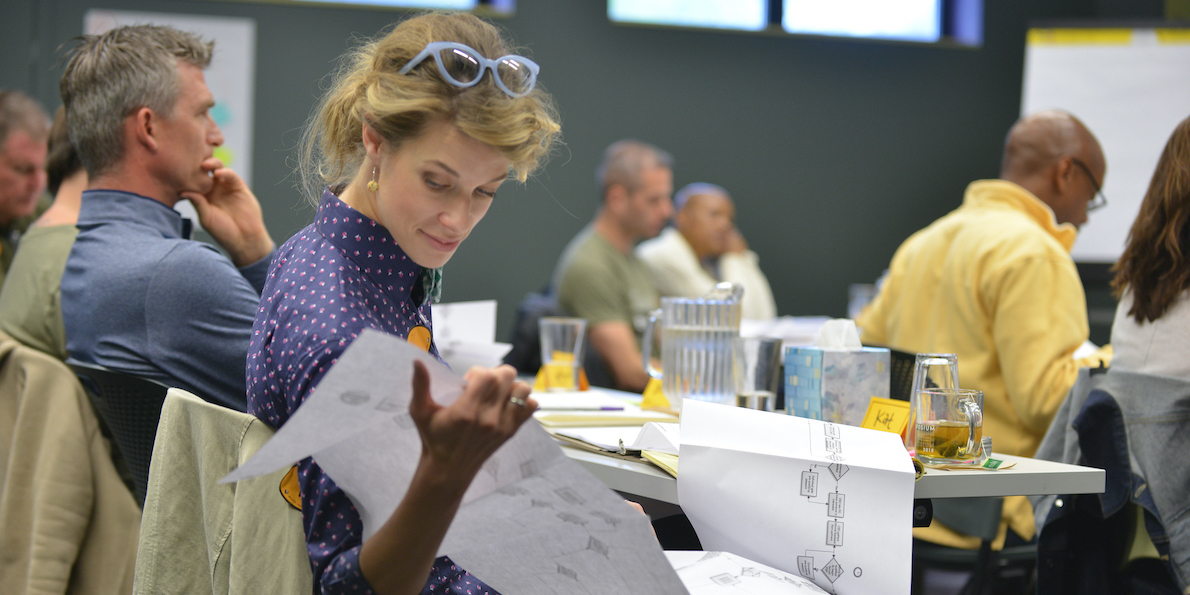
Transforming our training company
FEATURE – To lean out a training organization means to both transform its internal processes and integrate Lean Thinking in its educational offering: the story of ZingTrain.
Words: Katie Frank, Co-managing Partner, ZingTrain and Arianna Tellez, Trainer, ZingTrain with Teri Laeder, Process Engineer, Zingerman’s Delicatessen Inc.
Around 10 years after they founded Zingerman’s Delicatessen, Ari Weinzweig and Paul Saginaw laid out a new vision for the organization and decided to create a community of businesses that allow for organizational growth without replication. They had always believed strongly in people development and in the importance of customer service, so when their friend Maggie Bayless – who at the time was working for a small consulting firm – offered to start a new Zingerman’s business offering internal training programs, they didn’t have to think about it twice. In fact, Paul told Maggie that the new business should provide staff training to not only Zingerman’s people, but also to others who might be interested. That’s how ZingTrain was born (Maggie is now co-managing partner). It was 1994. ZingTrain delivered our first seminar in 1996 and have had steady growth ever since.
The content we teach is first used within the organization. It filters up through the business. In terms of our offering, however, lean is very much the new kid on the block. Around 10% of our pre-Covid training is officially focused on it (in 2019, we delivered our first two lean seminars), even though a lot of what we teach actually has continuous improvement at its core. We want to really feel comfortable with our understanding of lean before we start teaching more of it, and we want to make sure that what we offer really works for our clients.
Our lean expertise originates from Mail Order, the first business to dive into Lean Thinking and championing it across our community. Tom Root, Mail Order’s Managing Partner and enthusiastic lean ambassador, was using three basic classes to introduce lean to his staff: one on the Toyota House (something of an introduction to all things lean), one on writing SOPs and one on how to improve. Tom has been working hard to spread lean thinking and practice across the Zingerman’s Community of Businesses, and he’s been able to do so in a number of organizations. However, we cannot rely entirely on him: we have recently realized that our work at ZingTrain can help to shape the way internal training happens at Zingerman’s, to ensure we really take the knowledge away from the experts and give it to the people. In particular, we find that getting people to want that information is often difficult (lean learning at Zingerman’s typically happens in pull, meaning that the information is provided to people when they ask for it). We are now looking into how ZingTrain can help the rest of the business to build Lean Thinking into the onboarding classes people take upon being hired. We want to build lean into that foundation. Beyond that, we are excited to teach the methodology in use at Mail Order to spread the use of lean thinking across the organization and in other businesses as well (most of our clients are small organizations, 40% of which operate in the food sector).
It's clear that lean is very different from other things we teach. The concepts might feel a bit “out there” at first, which is why it’s critical to tie them to the actual work people are doing and to some hands-on exercises. Otherwise, the leap is just too hard to make (harder now that we are forced to provide our training online). That’s why, for instance, we begin with a one-piece flow exercise, to break the brain’s tendency to think in batches and to introduce a different way of thinking – one based on the scientific method. Everything we teach – whether it is five steps for handling complaints or six effective measures of a servant leader – is broken down into bite-sized pieces and followed by a practical exercise and a reflection with other participants (that’s often when the best learning takes place).
We are in the process of defining how lean might influence what we teach and how we teach it, but there are already a few things that make our approach at ZingTrain very compatible with it. For example, the fact that we tend to look at things holistically. People often think that to improve, say, customer service, all you need to do is to send your front desk person to a seminar, when actually this requires the commitment of the whole organization. Those who attend our seminars understand that we are encouraging them to rethink their whole approach, not to just change one thing – and that’s what Lean Thinking teaches us. We also realize – and teach – that real change requires time, as lean practitioners know all too well. There’s more: we always teach organizations to engage with the people who are closest to the work. We might be new to lean, but we think our thinking is very much in tune with it.
IMPROVING OUR OWN PROCESSES
To teach lean means to deeply understand it, which is why shortly after starting to learn about it the methodology began to seep into ZingTrain and transform our processes as well. By using lean ourselves and having direct experience with it, we feel more confident and comfortable sharing it with others. What we are doing at ZingTrain is experimenting in the field of education while trying to tackle our problems as we deliver courses.
For lean, the foot in the door at ZingTrain was an opportunity to streamline the work of event support staff. A lot of this work was repeatable, but the lack of dedicated professionals meant that new people were regularly called to carry out the process and that each time they had to be retrained. (Someone might work with us for three weeks and then not come back for six months, during which the processes would of course change.) Inspired by what Mail Order was doing, we created a task board and began to document the standards using our experience with SOPs. We came up with new ways to document and share information, so that it’d become easier for us to use but also to teach others.
Right now, we're in the process of improving how we manage customer orders. Due to the pandemic, we had to furlough a few people and we currently cannot afford to have one person only working on our inbox. As a consequence, everyone now uses it whenever information has to be inserted into the system, but there is no consistency or standard. When a client purchases a course or a seminar, we get the notification in our inbox and type customer information into a separate spreadsheet. Until a few weeks ago, we would manually send an email out that would say, “Welcome, we're excited to have you in our workshop.” We since then automated that part of the process, but we are now looking into whether we actually need the spreadsheet at all (we could pull that report out of Shopify, for instance). This improvement work is particularly important because we are currently growing the number of seminars and workshops we offer (we are used to doing two or three per month and now we are offering up to 12). This means the workload to sort through, which calls for a better system. Our transaction total is now higher, but our transactions tend to be of a lower amount. We are struggling to overlay our current system with a higher volume of low-amount transactions, and we see huge opportunities for improvements here.
Another project that was under way before Covid-19 took the world to storm was the creation of a knowledge base to make it easier for everyone (and not just trainers) to talk about ZingTrain’s different offerings. This project stemmed from an eye-opening off-site last year, during which we asked staff about the different topics we train clients on and realized they didn't really understand the difference between different seminars and workshops.
COPING WITH COVID
The Coronavirus pandemic has made our way of operating obsolete in the blink of an eye. Our current focus is to try and generate as much revenue as we can to try and retain our staff. When the crisis began, we had to let go our four event support staff and furlough our core team of seven for five weeks, during which we tried to understand what our next move should be. As you can imagine, our focus quickly moved to e-learning.
In a month and a half, we turned our four-hour in-person workshops into two-and-a-half-hour virtual workshops. We also organized 13 one-hour sessions between May and June. This rather quick pivot allowed us to increase our revenue dramatically, from 14k in April to 42k in May and 60k in June. Right now, our focus is on breaking even and we are hoping to get there soon. It's pretty fast and furious, and obviously very intense, at the moment, as we've gone from a totally mature business in a comfortable position to a startup in hustle mode in a matter of days.
Our plan is to diversify our offerings so that people can consume our content in the way that's going to work best for them, acknowledging also that we're now selling to a clientele that we've never sold to before (online training is not a format we know well). We are learning new things every day and understand that we will have to continue this, because we don’t expect being able to give in-person training for another year or so.
In true lean spirit, we are constantly engaging in experimentation. We are trying new things, adjusting our stance whenever they don’t work and trying to change different variables (like, offering the same workshop at a different time). What’s really exciting is that ZingTrain has an extraordinary inventory of information, but it’s buried in different people's heads, we have now begun to document it more and more (a trend we are actually seeing across Zingerman’s). As we reflect on the past three-four months, it’s clear to us that Covid-19 has not been all bad for us: people are now in a growth mindset, and more open than they ever have been.
THE AUTHORS



Read more


RESEARCH - Offering us a glimpse into how the human mind works and into Toyota's approach to people engagement, this article tells us how to create a better working environment for our employees.


FEATURE – A former ops manager now tasked for improvement across IKEA looks back at what she learned in one of the company’s stores and explains how she hopes to take lean to the whole group.


PROFILE – Persevering, letting people inspire you and committing to continuous learning. These are the things you need to do to successfully embrace lean thinking and, it turns out, learn to play the violin.


VIDEO INTERVIEW – This hotel in the Canary Islands is bringing lean to its Kitchen Department, hoping to streamline the process and provide a better service to diners.

